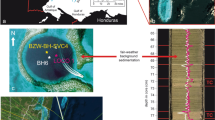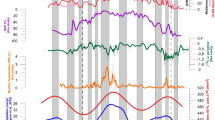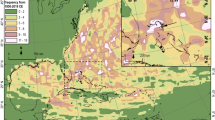Abstract
The processes that control the formation, intensity and track of hurricanes are poorly understood1. It has been proposed that an increase in sea surface temperatures caused by anthropogenic climate change has led to an increase in the frequency of intense tropical cyclones2,3, but this proposal has been challenged on the basis that the instrumental record is too short and unreliable to reveal trends in intense tropical cyclone activity4. Storm-induced deposits preserved in the sediments of coastal lagoons offer the opportunity to study the links between climatic conditions and hurricane activity on longer timescales, because they provide centennial- to millennial-scale records of past hurricane landfalls5,6,7,8. Here we present a record of intense hurricane activity in the western North Atlantic Ocean over the past 5,000 years based on sediment cores from a Caribbean lagoon that contain coarse-grained deposits associated with intense hurricane landfalls. The record indicates that the frequency of intense hurricane landfalls has varied on centennial to millennial scales over this interval. Comparison of the sediment record with palaeo-climate records indicates that this variability was probably modulated by atmospheric dynamics associated with variations in the El Niño/Southern Oscillation and the strength of the West African monsoon, and suggests that sea surface temperatures as high as at present are not necessary to support intervals of frequent intense hurricanes. To accurately predict changes in intense hurricane activity, it is therefore important to understand how the El Niño/Southern Oscillation and the West African monsoon will respond to future climate change.
This is a preview of subscription content, access via your institution
Access options
Subscribe to this journal
Receive 51 print issues and online access
$199.00 per year
only $3.90 per issue
Buy this article
- Purchase on Springer Link
- Instant access to full article PDF
Prices may be subject to local taxes which are calculated during checkout



Similar content being viewed by others
References
Goldenberg, S. B., Landsea, C. W., Mestas-Nunez, A. M. & Gray, W. M. The recent increase in Atlantic hurricane activity: Causes and implications. Science 293, 474–479 (2001)
Emanuel, K. Increasing destructiveness of tropical cyclones over the past 30 years. Nature 436, 686–688 (2005)
Webster, P. J., Holland, G. J., Curry, J. A. & Chang, H.-R. Changes in tropical cyclone number, duration, and intensity in a warming environment. Science 309, 1844–1846 (2005)
Landsea, C. W., Harper, B. A., Hoarau, K. & Knaff, J. A. Can we detect trends in extreme tropical cyclones. Science 313, 452–454 (2006)
Liu, K. B. & Fearn, M. L. Reconstruction of prehistoric landfall frequencies of catastrophic hurricanes in northwestern Florida from lake sediment records. Quat. Res. 54, 238–245 (2000)
Donnelly, J. P. et al. 700 yr sedimentary record of intense hurricane landfalls in southern New England. Geol. Soc. Am. Bull. 113, 714–727 (2001)
Donnelly, J. P., Butler, J., Roll, S., Wengren, M. & Webb, T. A backbarrier overwash record of intense storms from Brigantine, New Jersey. Mar. Geol. 210, 107–121 (2004)
Donnelly, J. P. Evidence of past intense tropical cyclones from backbarrier salt pond sediments: A case study from Isla de Culebrita, Puerto Rico, USA. J. Coast. Res. SI42, 201–210 (2005)
Roy, P. S., Cowell, P. J., Ferland, M. A. & Thom, B. G. in Coastal Evolution: Late Quaternary Shoreline Morphodynamics (eds Carter, R. W. G. & Woodroffe, C. D.) 121–186 (Cambridge Univ. Press, Cambridge, UK, 1994)
Cooper, J. A. G. Beachrock formation in low latitudes—implications for coastal evolutionary models. Mar. Geol. 98, 145–154 (1991)
Lighty, R. G., Macintyre, I. G. & Struckenrath, R. Acropora Palmata reef framework: a reliable indicator of sea level in the western Atlantic for the past 10,000 years. Coral Reefs 1, 125–130 (1982)
Boose, E. R., Serrano, M. I. & Foster, D. R. Landscape and regional impacts of hurricanes in Puerto Rico. Ecol. Monogr. 74, 335–352 (2004)
Scileppi, E. & Donnelly, J. P. Sedimentary evidence of hurricane strikes in western Long Island, New York. Geochem. Geophys. Geosyst. (in the press)
Elsner, J. B., Liu, K. B. & Kocher, B. Spatial variations in major US hurricane activity: Statistics and a physical mechanism. J. Clim. 13, 2293–2305 (2000)
Emanuel, K. The dependence of hurricane intensity on climate. Nature 326, 483–485 (1987)
Nyberg, J., Malmgren, B. A., Kuijpers, A. & Winter, A. A centennial-scale variability of tropical North Atlantic surface hydrography during the late Holocene. Palaeogeogr. Palaeoclimatol. Palaeoecol. 183, 25–41 (2002)
Winter, A., Ishioroshi, H., Watanabe, T., Oba, T. & Christy, J. Caribbean sea surface temperatures: two to three degrees cooler than present during the Little Ice Age. Geophys. Res. Lett. 27, 3365–3368 (2000)
Garcia-Herrera, R., Gimeno, L., Ribera, P. & Hernandez, E. New records of Atlantic hurricanes from Spanish documentary sources. J. Geophys. Res. 110, 1–7 (2005)
Gray, S. T., Graumlich, L. J., Betancourt, J. L. & Pederson, G. T. A tree-ring-based reconstruction of the Atlantic Multidecadal Oscillation since 1567 A.D. Geophys. Res. Lett. 31, 1–4 (2004)
Gray, W. M. Atlantic seasonal hurricane frequency. Part I: El Nino and 30 mb quasi-biennial oscillation influences. Mon. Weath. Rev. 112, 1649–1668 (1984)
Bove, M. C., Elsner, J. B., Landsea, C. W., Niu, X. F. & O'Brien, J. J. Effect of El Nino on US landfalling hurricanes, revisited. Bull. Am. Meteorol. Soc. 79, 2477–2482 (1998)
Moy, C. M., Seltzer, G. O., Rodbell, D. T. & Anderson, D. M. Variability of El Nino/Southern Oscillation activity at millennial timescales during the Holocene epoch. Nature 420, 162–165 (2002)
Nguetsop, V. F., Servant-Vildary, S. & Servant, M. Late Holocene climatic changes in west Africa, a high resolution diatom record from equatorial Cameroon. Quat. Sci. Rev. 23, 591–609 (2004)
Bell, G. D. & Chelliah, M. Leading tropical modes associated with interannual and multidecadal fluctuations in North Atlantic hurricane activity. J. Clim. 19, 590–612 (2006)
Cook, K. H. Generation of the African easterly jet and its role in determining West African precipitation. J. Clim. 12, 1165–1184 (1999)
Janicot, S., Harzallah, A., Fontaine, B. & Moron, V. West African monsoon dynamics and eastern equatorial Atlantic and Pacific SST anomalies (1970–88). J. Clim. 11, 1874–1882 (1998)
Weldeab, S., Schneider, R. R., Kolling, M. & Wefer, G. Holocene African droughts relate to eastern equatorial Atlantic cooling. Geology 33, 981–984 (2005)
Croudace, I. W., Rindby, A. & Rothwell, R. G. ITRAX: description and evaluation of a new X-ray core scanner. In New Techniques in Sediment Core Analysis (ed. Rothwell, R. G.) Geol.. Soc. Lond. Spec. Publ. 267, 51–63 (2006)
Reimer, P. J. et al. IntCal04 terrestrial radiocarbon age calibration, 0–26 cal kyr BP. Radiocarbon 46, 1029–1058 (2004)
Hughen, K. A. et al. Marine04 marine radiocarbon age calibration, 0–26 cal kyr BP. Radiocarbon 46, 1059–1086 (2004)
Acknowledgements
Funding for this research was provided by the National Science Foundation, the Risk Prediction Initiative, the National Geographic Society, the Coastal Ocean Institute at Woods Hole Oceanographic Institution, and the Andrew W. Mellon Foundation Endowed Fund for Innovative Research. We are grateful to E. Bryant, E. Scileppi, J. Tierney, and A. Jovanovic who assisted with the field and laboratory work. E. Uchupi and P. Lane provided advice and D. Oppo, J. Russell, T. Webb III, K. Emanuel and L. Giosan made suggestions for improving this manuscript. This is a contribution of IGCP 495—‘Holocene land-ocean interactions: driving mechanisms and coastal responses’.
Author information
Authors and Affiliations
Corresponding author
Ethics declarations
Competing interests
Reprints and permissions information is available at www.nature.com/reprints. The authors declare no competing financial interests.
Supplementary information
Supplementary Information
This file contains Supplementary Figures S1-S3, Supplementary Table S1 and additional references. (PDF 554 kb)
Rights and permissions
About this article
Cite this article
Donnelly, J., Woodruff, J. Intense hurricane activity over the past 5,000 years controlled by El Niño and the West African monsoon. Nature 447, 465–468 (2007). https://doi.org/10.1038/nature05834
Received:
Accepted:
Issue Date:
DOI: https://doi.org/10.1038/nature05834
This article is cited by
-
Last millennium hurricane activity linked to endogenous climate variability
Nature Communications (2024)
-
Paleoecological history of Eleuthera Island, the Bahamas, based on pollen and charcoal analyses from two lakes
Journal of Paleolimnology (2024)
-
Marine inundation history during the last 3000 years at Lake Kogare-ike, a coastal lake on the Pacific coast of central Japan
Progress in Earth and Planetary Science (2023)
-
Spatiotemporal semantic network for ENSO forecasting over long time horizon
Applied Intelligence (2023)
-
Poleward expansion of tropical cyclone latitudes in warming climates
Nature Geoscience (2022)
Comments
By submitting a comment you agree to abide by our Terms and Community Guidelines. If you find something abusive or that does not comply with our terms or guidelines please flag it as inappropriate.



